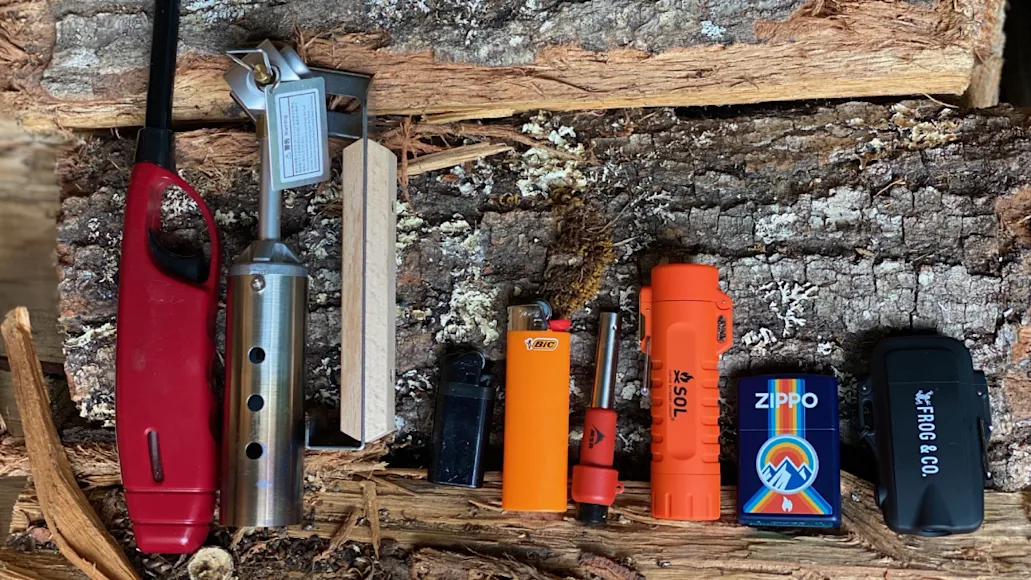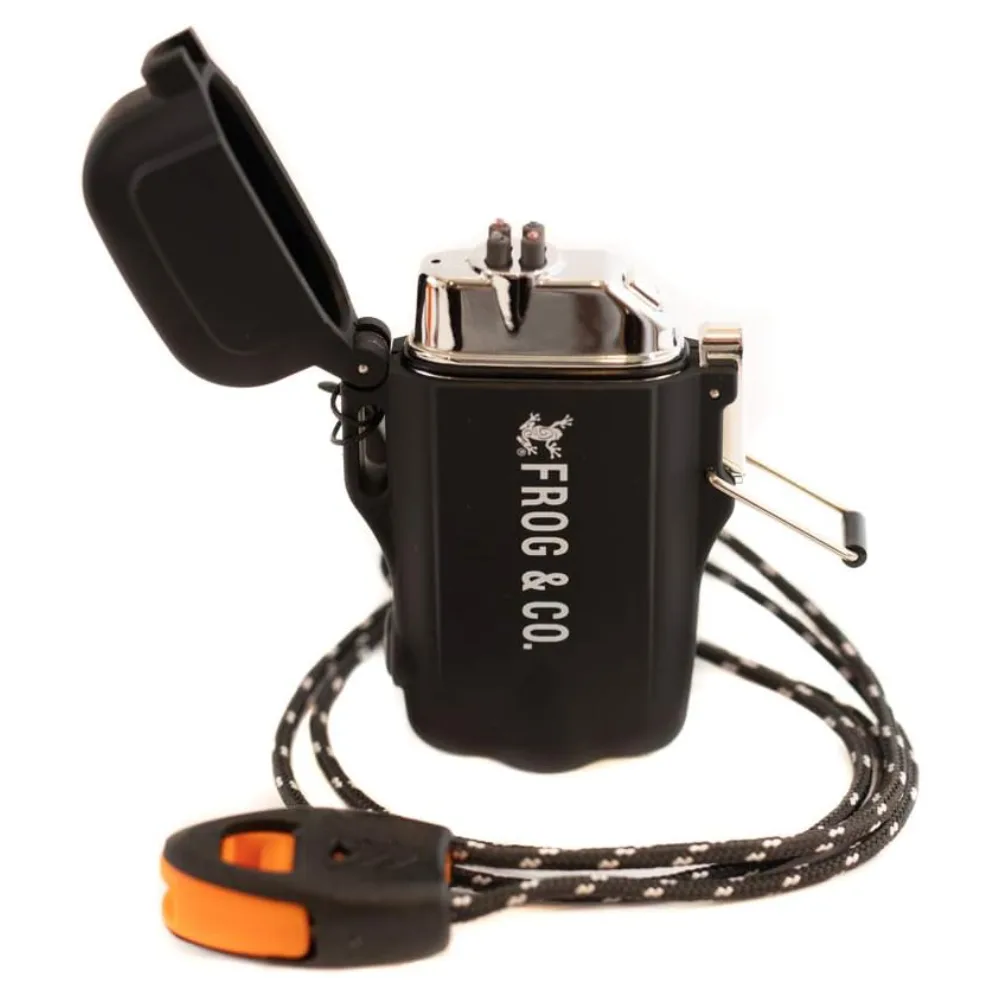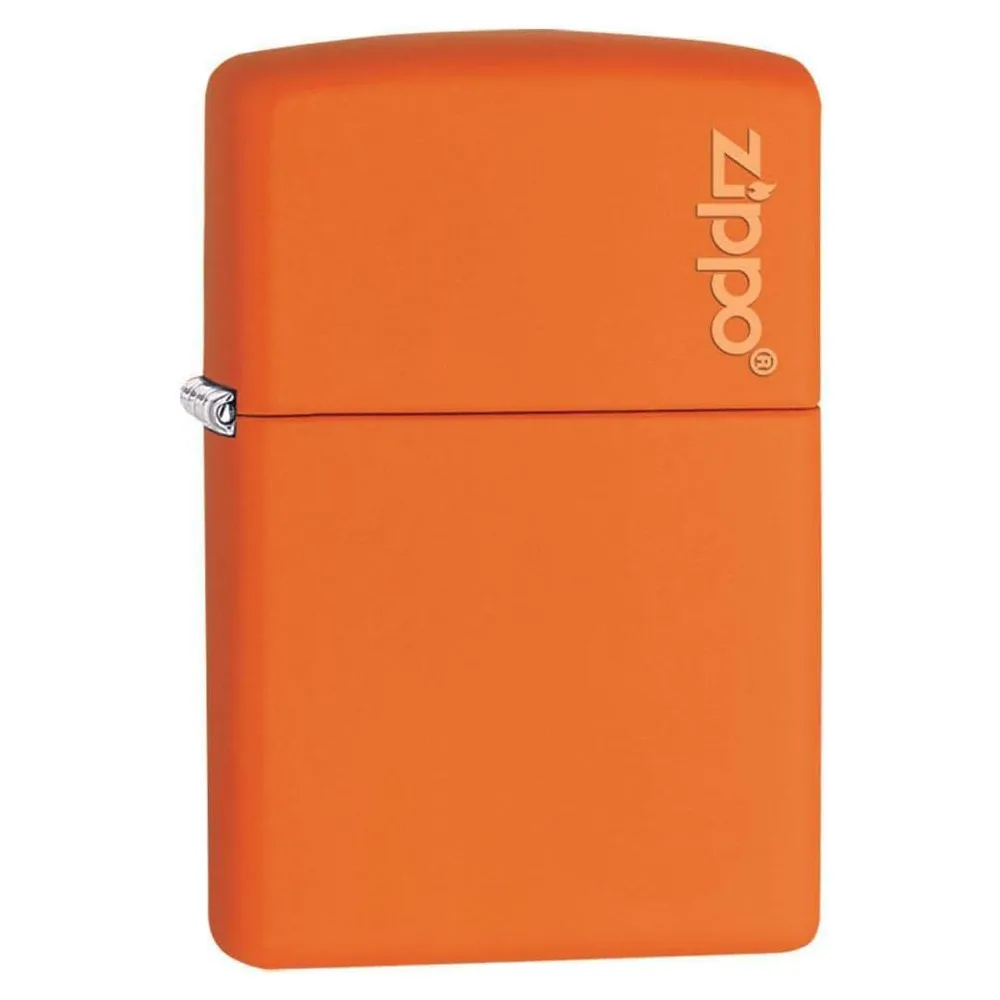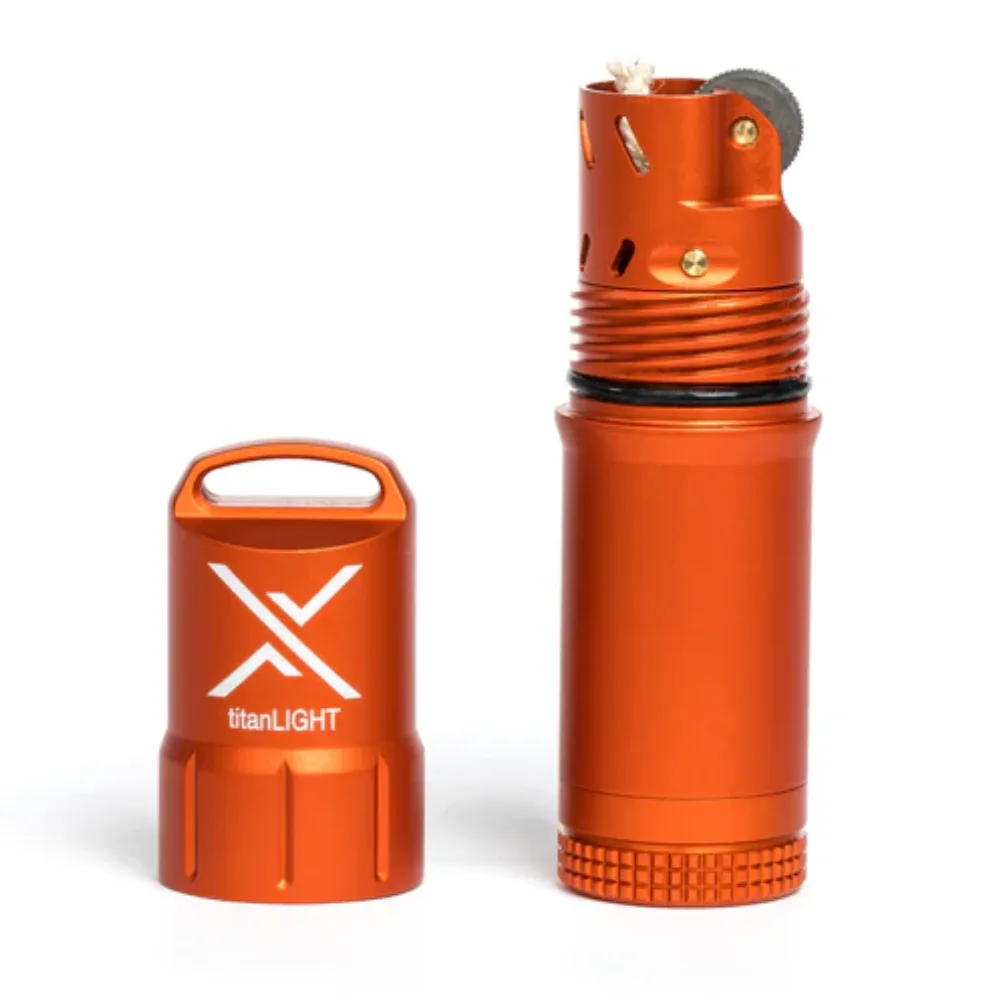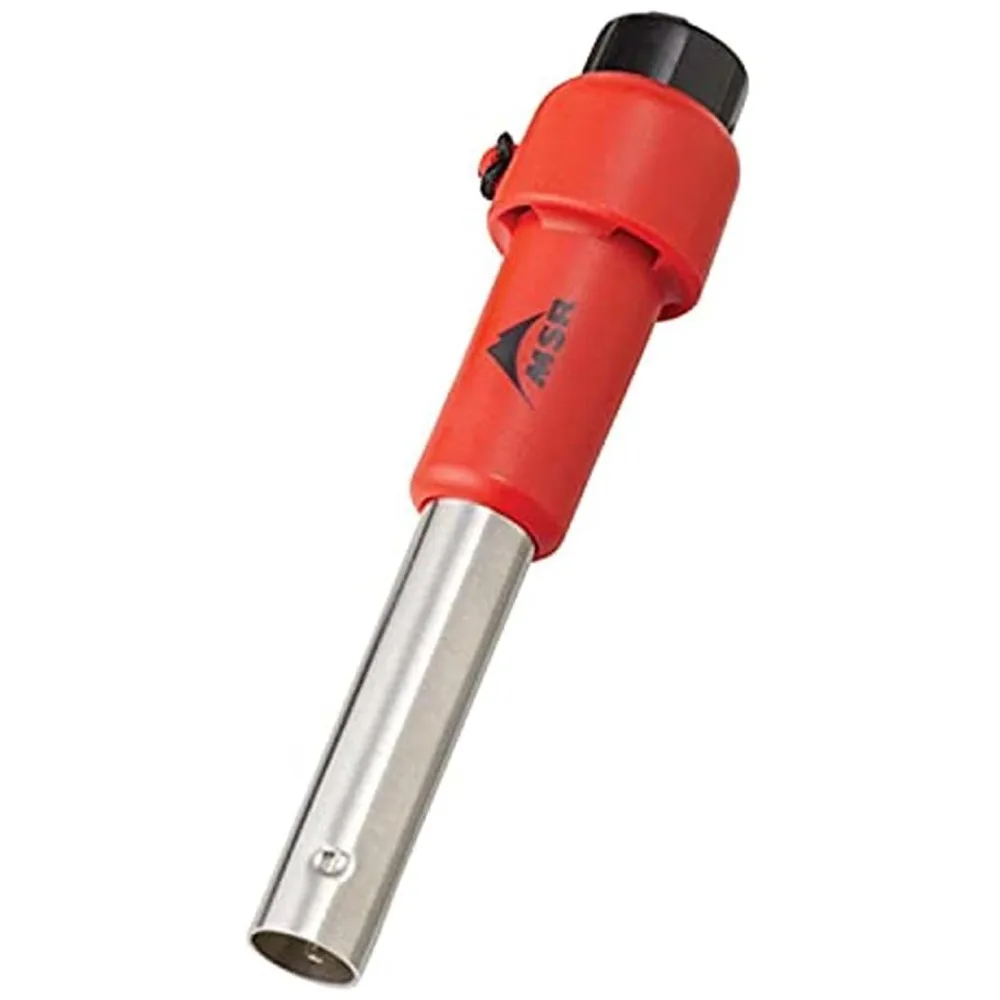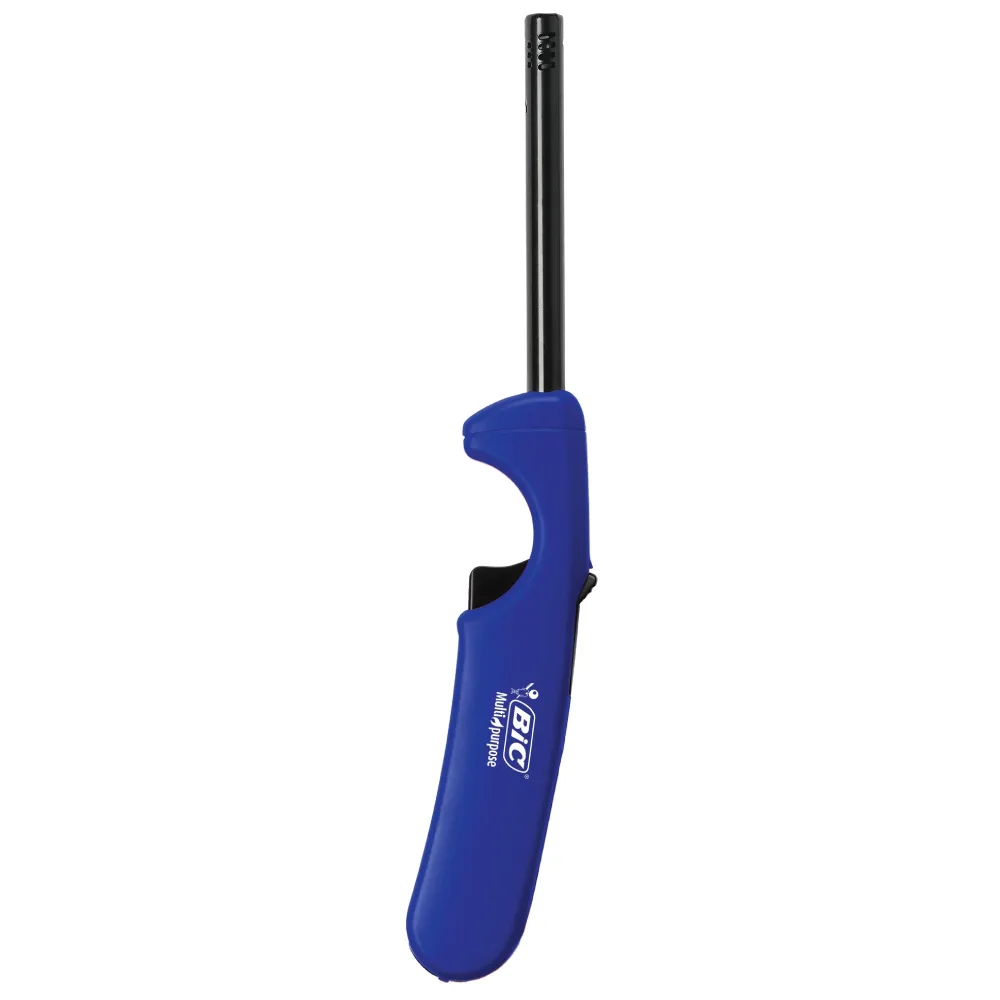We may earn revenue from the products available on this page and participate in affiliate programs. Learn more
A reliable camping lighter can make the difference between a comforting campfire and a fight against the elements. We tested out some of the most popular lighters from brands like Zippo, Bic, and MSR to find which ones performed in even the most treacherous conditions. We evaluated them on durability, weather resistance, ease of use, and additional features.
Whether you’re a seasoned backpacker or casual camper, our selection of top-notch lighters is sure to cater to every need and preference. From windproof arc and plasma lighters to dependable torches, these are the best camping lighters—and the best fire-starting companions—for your next outdoor endeavor.
Best Overall: Exotac TitanLight
Best Arc: Survival Frog Tough Tesla Lighter 2.0
Best Butane: Zippo Classic Lighter with Butane Insert
Best Windproof: Dark Energy Plasma Lighter
Best Torch: Snow Peak Folding Torch
Best for Backpacking: MSR Piezo Igniter
Best Budget: Bic Multi-Purpose Lighter
Best For Campgrounds: SOTO Pocket Torch
Best Overall: Exotac TitanLight
Specs
Type: Zippo lighter fluid
Weight: 2 oz
Refillable: Yes
Features: Water- and evaporation-proof casing
Pros
Waterproof and windproof
Low fuel evaporation
Constant flame
Cons
Expensive
The Exotac TitanLight is made for the rugged outdoorsman or woman. Crafted with durability in mind, this refillable lighter features a fabric wick and flint wheel igniter. The body of the lighter is constructed from solid aluminum and sealed with O-rings on both the threaded base and cap, which prevents leaks and fuel loss due to evaporation. The design is waterproof up to 1 meter, as well as wind-resistant and overall extremely robust.
It’s similar to the classic Zippo in that it uses Zippo lighter fluid and provides a constant and steady flame until capped. You conveniently don’t have to hold down a button or trigger, so it’s perfect for hands-free fire lighting. This feature also makes it a great tool for anyone with hand dexterity issues. While the Exotac TitanLight is more expensive, it’s a worthwhile investment for those seeking durability and reliability in a refillable camping lighter.
Best Arc: Survival Frog Tough Tesla Lighter 2.0
Specs
Type: Plasma/arc/electric
Weight: 1.8 oz
Refillable: Fuel-free rechargeable
Features: Flashlight, tinder chord lanyard, and safety whistle, waterproof casing
Pros
Waterproof
Rechargeable
Has a lot of built-in survival features
Cons
Ignite button puts fingers close to dual arc
Battery dies under extreme cold
Also called an electric lighter or plasma lighter, the Survival Frog Tough Tesla 2.0 is the best arc lighter for camping. Instead of a traditional flame, it employs a powerful electric double arc. During our testing, the Tough Tesla lit instantly with a push of the button—making it very helpful for anyone trying to light a fire with cold stiff fingers. In addition, this model had almost no notable effect with wind and water. The Tough Tesla’s casing is durable and protective and has some great camping survival extras including a built-in LED flashlight, strobe light, safety whistle, and versatile lanyard equipped with a fire cord. As an electric lighter, I liked the idea of not having to worry about running out of fuel or refilling.
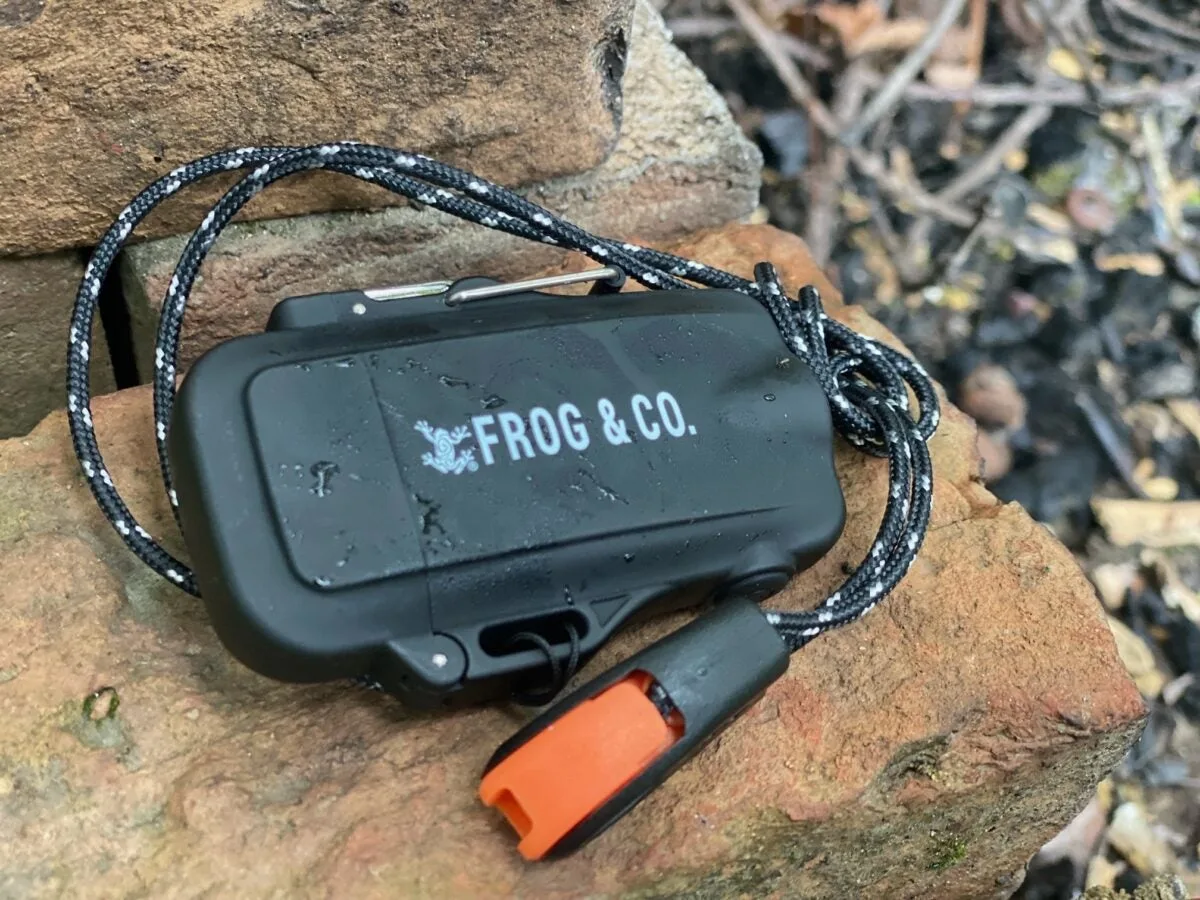
However, I’d encourage campers who bring portable power banks to also pack the tiny USB cord to recharge the lighter when it dies. In our cold test, it stopped working after an hour in the freezer but fortunately regained power within five minutes at room temperature. Therefore, if you’re hiking or camping in the winter, I recommend storing this next to your body or keeping it insulated within a pack.
While it was overall difficult to find fault with this camping lighter, I personally found that the ignition button placed my thumb a little too close to the dual arc for comfort. This raised concerns about an accidental shock and burn. Despite this minor consideration, the Tough Tesla 2.0 excels on its reliability, weather resistance, and great survival extras.
Best Butane: Zippo Classic Lighter with Butane Insert
Specs
Type: Butane
Weight: 2 oz
Refillable: Yes
Features: Optional inserts and all-metal design
Pros
Refillable
Wind-resistant
Lasts a long time
Comes in a bunch of fun designs
Cons
No locked flame like the original Zippo insert
It’s hard not to be enamored with the sleek metal design on a Zippo lighter, but my big complaint has always been the fuel. Zippo lighter fluid is prone to leaking and evaporation, which doesn’t give me confidence that it will be the trusted tool I need on my camp trip. Enter the butane insert.
Unlike the original Zippo, this version is pressurized and not only delivers a focused flame, but also ensures that butane remains sealed, extending the time between refills. I tested the yellow flame pipe lighter insert within the body of a Zippo Outdoor lighter.
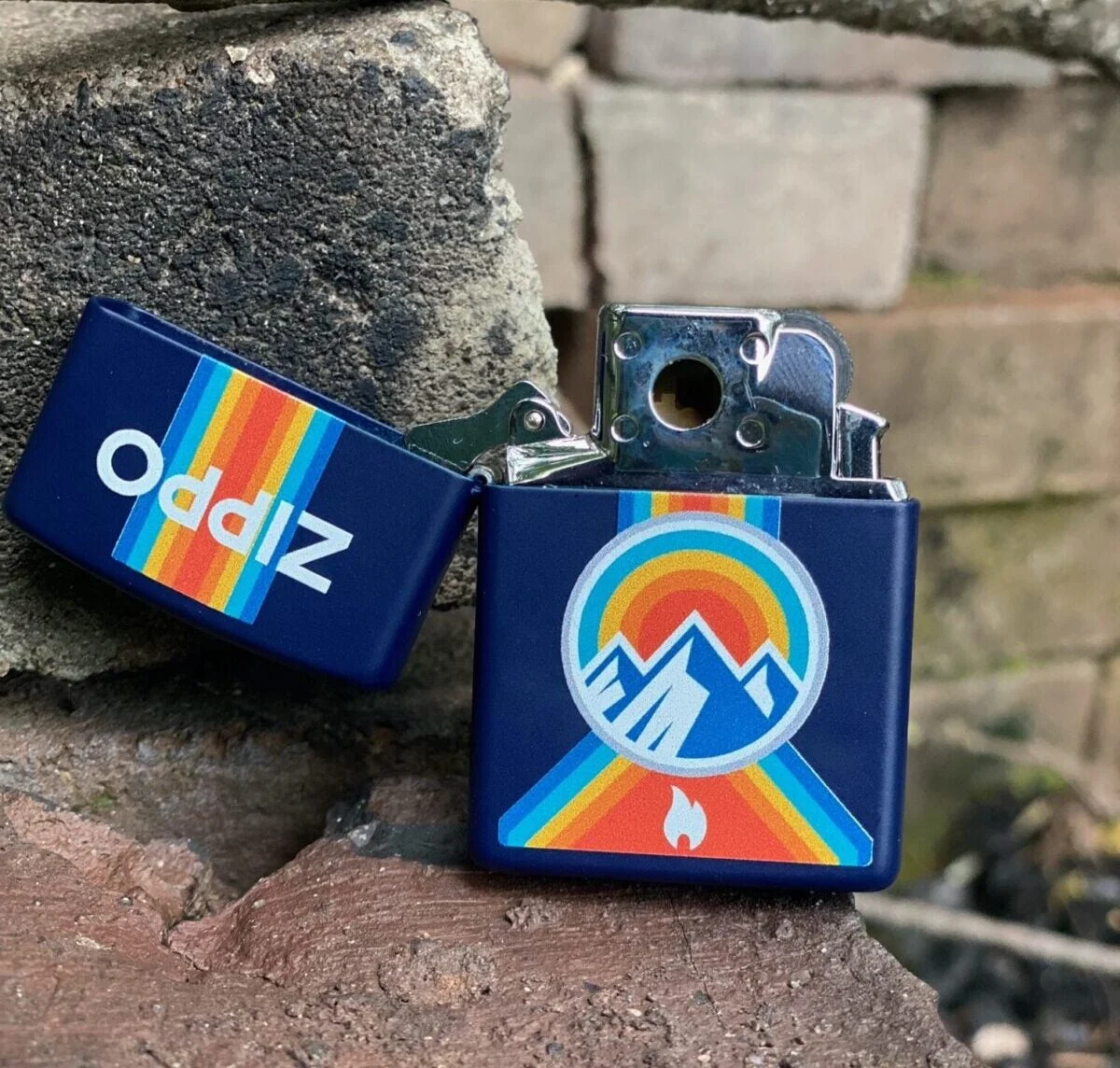
I like that it features a classic wheel and flint ignition. I was impressed by the prolonged, bright yellow flame and easy ignition. Additionally, it outperformed the electronic lights in my freezer test. It was still producing a flame after an hour in the freezer. And if you prefer a torch butane option, Zippo offers that alternative as well.
The only frustration I experienced was the absence of a locked flame feature, which is a characteristic present in the original Zippo insert. Despite this minor drawback, this turned out to be a perfect refillable lighter that brought reliability and style to my camp kit.
Best Windproof: Dark Energy Plasma Lighter
Specs
Type: Plasma (Electric)
Weight: 2.26 oz
Refillable: No fuel required
Features: 120-lumen light and strobe
Pros
USB charging
Waterproof and wind resistant
Bonus flashlight is useful
Cons
Slightly more difficult to use than a standard lighter
The Dark Energy plasma lighter is an interesting piece of technology that’s a bit more niche, but it never requires fuel refilling. That’s because plasma lighters produce a high-voltage electrical current to ignite flammable materials. What makes Dark Energy’s lighter intriguing is that it never requires butane or other fuel. It creates this current via a rechargeable battery. Hook it up before each adventure to top off the battery, and it's good to go. Another bonus is that the electrical current makes this lighter waterproof and windproof. It doesn’t get much simpler than that. In an off-grid scenario with a solar generator and solar panel, it should be possible to keep it running indefinitely.
One downside is that plasma lighters are slightly more challenging to use than standard lighters. It doesn’t produce a direct flame. That means the user needs good flammable material to get things going. Knowing this, the Dark Energy is better suited for experienced campers who have experience making fires with a variety of materials. Still, we like the idea of spending $30 on this lighter and then never needing to worry about fuel again.
Best Torch: Snow Peak Folding Torch
Specs
Type: Isobutane torch
Weight: 10.1 oz
Refillable: Yes, replace gas canister
Features: Foldable with storage pouch included
Pros
Quickly and efficiently lights a campfire
Powerful flame
Folds down small
Cons
Lighter still needed to ignite
Fuel sold separately
The Snow Peak Folding Torch was definitely one of our favorite camping lighters to test. This innovative tool proved its worth—I was able to effortlessly light my campfires without needing kindling or a fire starter. We successfully initiated multiple campfires using only chopped wood. Not only is this extremely convenient, it’s also great for those who need fire for warmth quickly in a wilderness space.
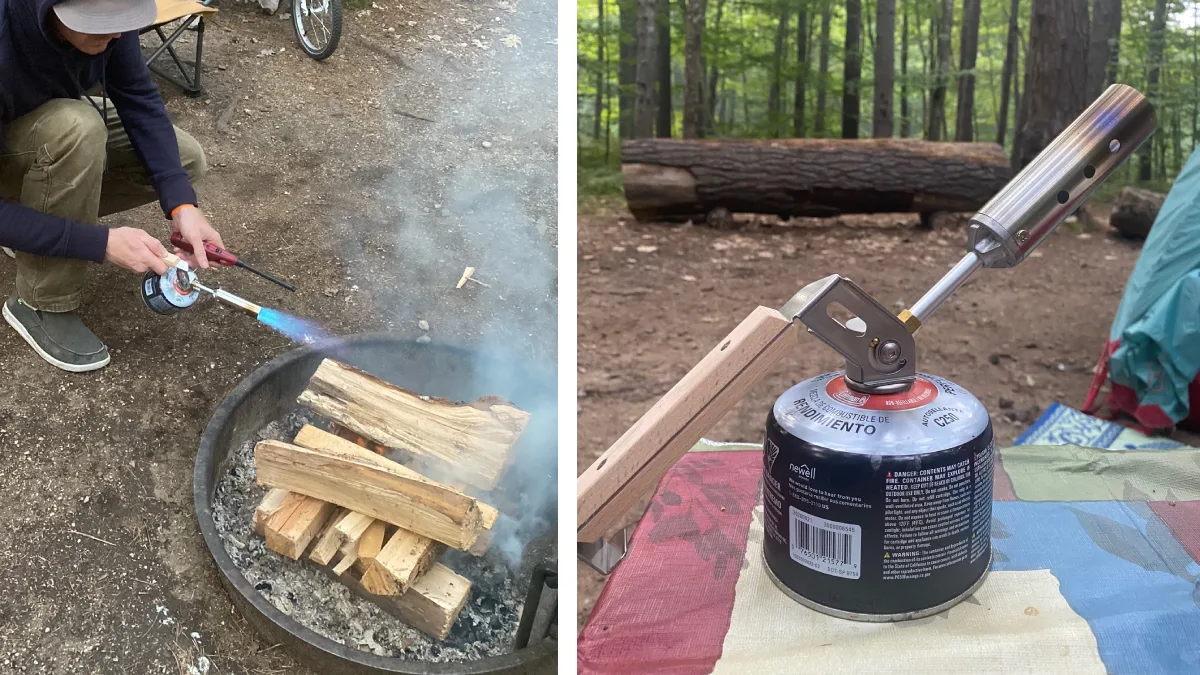
The Snow Peak folding torch has a compact, foldable design with an included carrying satchel. It’s easy and straightforward to operate: Just unfold the torch, attach a backpacking-style iso-butane fuel canister, adjust the gas release knob, and ignite with a lighter. The result is a powerful flame that feels fun (and possibly a little dangerous) to use. While it’s a great camping accessory, the need for fuel canisters and lighters for ignition make it slightly less convenient and a better choice for car camping over backpacking.
Best for Backpacking: MSR Piezo Igniter
Specs
Type: Spark igniter
Weight: 0.5 oz
Refillable: No fuel necessary
Features: Hole for lanyard
Pros
Ultralight
No fuel or charge needed
Safe
Cons
Should be longer for large camp stoves
Convenient, lightweight, and safer than other lighters, the MSR Piezo Igniter is perfect for backpacking stoves. Its push-button operation delivers a spark to light a gas stove without the risk of burning your hand on the lighter flame. As an avid backpacker, I appreciate how portable and reliable it is. I don’t have to worry that I’ll run out of fuel or battery charge on my lighter—this will light my stove every time and it doesn’t add much weight to my backpacking backpack.
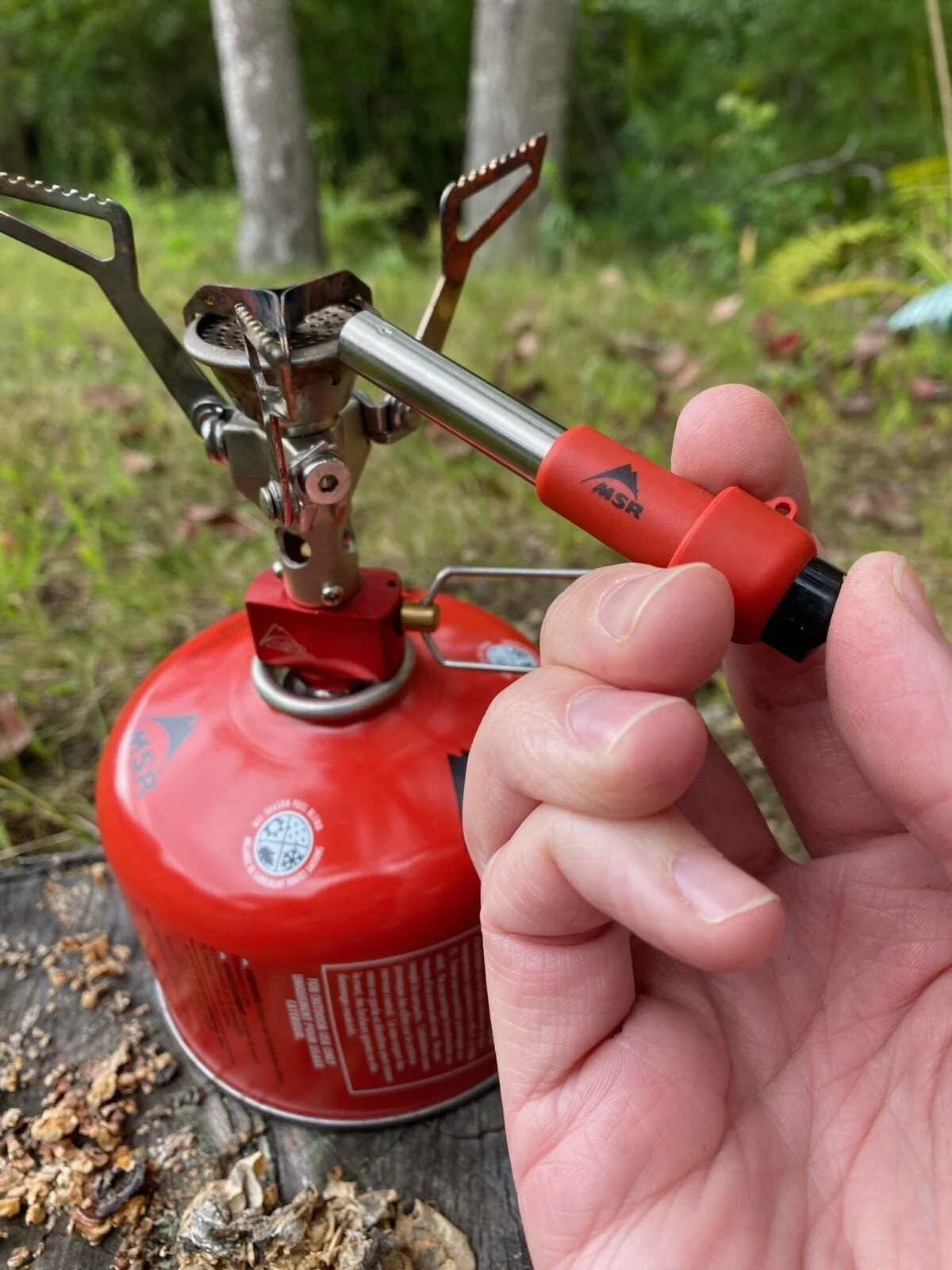
Even in the windiest conditions, I had success quickly lighting my stove with the MSR lighter even when other lighters failed. While this is perfectly suited for backpacking stoves like my trusty MSR PocketRocket, I find myself wishing it were a bit longer for my larger camp stove. Nonetheless, it remains an indispensable tool for hassle-free and safe stove ignition on camping adventures.
Best Budget: Bic Multi-Purpose Lighter
Specs
Type: Butane
Weight: 2.7 oz
Refillable: No
Features: Child-resistant safety trigger
Pros
Affordable
Long wand design protects hands from flame
Child-resistant safety button
Cons
Handles poorly in bad weather
Not refillable
Even with all my fancy lighters, the classic Bic Multi-Purpose Lighter has permanent residence in my camping box. The standout feature lies in the remarkably long arm, which allows it to reach deep into the heart of a campfire. It can also easily ignite gas grills, camping grills, lanterns, and camp candles. The Bic Multi-Purpose has a child-resistant safety design where you hold down the thumb button while simultaneously igniting it by pulling a trigger. This adds an extra layer of safety for those camping with kids.
While this budget option remains a staple on most of my camping trips, it has its limitations. Bic lighters perform less optimally in wet, cold, and windy conditions. Additionally, as with disposable lighters, once the fuel is depleted, it’s trash. Despite these considerations, its affordability and impressive range of applications make it a perfect choice for budget-conscious campers.
Best For Campgrounds: SOTO Pocket Torch
Specs
Type: Butane
Weight: 1.8 oz
Refillable: Yes
Features: Extendable burner head
Pros
Burns extremely hot
Refillable
Lightweight
Cons
Doesn’t operate well over 5,000 feet
The SOTO is a good option for anyone who frequents modern campgrounds but wants something more reliable than a cheap disposable. This pocket torch features an extendable burner head that easily extends into a small grill. At the same time, the lighter has a smaller footprint than a standard multi-purpose lighter. It’s a good option for saving drawer space in smaller van conversions and campers. The torch flame it produces burns at approximately 2,300 degrees, making it easy to light a campfire under any conditions. We also appreciate that this lighter is refillable. The price is usually under $30, making it highly affordable.
The one flaw of this lighter is that it wasn’t designed for higher elevations. Even SOTO’s website recommends against using it at elevations higher than 5,000 feet. That rules out many backcountry scenarios in the American West. This lighter is likely a better choice for Midwesterners or Southerners who require a reliable lighter that can withstand wind.
How We Tested Camping Lighters
As a lifelong camper and outdoor enthusiast, I’m all too aware that fire starting is an essential skill—and that a good lighter makes or breaks the experience. To determine the best camping lighters, I employed a methodology to evaluate their performance in challenging conditions.
To start, I wanted to see how the lighters performed in cold temperatures. I placed each one in the freezer for an hour and then assessed their functionality immediately after and then again 10 minutes later. The goal was to determine their ability to operate in extreme cold and whether they could regain functionality at room temperature if initially impaired.
Additionally, we conducted a wind test to provide an equitable assessment of each lighter’s performance. This involved subjecting them to a controlled wind environment in front of a fan to simulate real-world outdoor conditions. Lastly, I tested each lighter in camp scenarios by having them start a campfire and also light a backpacking stove.
By conducting these comprehensive tests, we aimed to offer a thorough and unbiased evaluation of each camping lighter’s capability to withstand the natural elements and perform under adverse conditions.
What To Consider When Choosing a Camping Lighter
Not every camper needs a hardcore lighter that spits a flame even after being frozen in ice or soaked in water. If the extent of your camping is a modern RV campground with modern hookups, an expensive lighter isn’t always necessary. However, backcountry campers and hunters will want to be more thoughtful. In some cases, a working lighter can be a matter of life or death in a survival situation. Here are some key points to keep in mind when picking out a reliable and suitable product:
Weather Resistance
Chances are, you’ll be mostly using this lighter outdoors. Opt for a windproof and waterproof design. Even then, it’s not a bad idea to budget for more than one. It’s better to have a backup and not need it than need it and not have it.
Durability
You want a lighter that will continue to work if it falls on a rock or stays out in the rain. Look for lighters with robust protective casings of the lighting mechanism for optimal protection. In addition, check for O-rings that seal the lighter against wind, snow, and rain.
Size and Portability
While this is especially important for backpackers, all campers should consider the bulkiness of their lighter. If electric, account for the bulk of a charging cord and power bank.
Refills and Longevity
Consider how long a lighter can burn continuously on a single refill or charge. In addition, check to see if the lighter is easy to refill. Lastly, think about the downtime between camping trips. Consider whether the lighter will sit unused for months or even years.
Batteries
Electric lighters can throw an enormous flame, making it easy to start a fire. However, ensure the batteries are readily available and easy to replace. Some batteries deteriorate quickly in cold weather, making these lighters less than ideal for use in freezing conditions.
Extra Features
Some lighters come with additional features like built-in lights, bottle openers, safety locks, or extra long arms. Narrow down which features are most important for your specific camping needs.
FAQS
Q: What kind of lighter is used in camping?
Butane or electric plasma arc lighters are the most common for camping. Butane lighters can either be disposable or refillable and are suitable for lighting camp stoves, campfires, and camping lanterns. Electric lighters are flameless and ignite using an electric arc. This makes them windproof—ideal for various outdoor camping conditions. Both types of lighters offer convenience and reliability for lighting fires on outdoor adventures.
Q: Are camping lighters waterproof?
Many camping lighters are designed to be waterproof. If you’re looking for a waterproof camping lighter, look for features such as O-rings, seals, and waterproof casings to protect the lighter’s internal components from moisture.
Q: How long do camping lighters last on average?
The lifespan of a camping lighter varies depending on factors such as frequency of use, quality, and maintenance. On average, a well-maintained camping lighter should last for several years. Disposable lighters provide over 1,000 lights, while refillable and rechargeable lighters can last significantly longer with proper care. In order to get the most out of your camping lighter, regularly replace fuel, replace flints and/or wick when needed, and store it in a dry and clean location.
Final Thoughts
A camping lighter is an essential piece of camping gear for every outdoor enthusiast. These reliable tools provide a sense of security and allow campers to confidently survive in the wilderness. Just like we all have personal preferences in outdoor adventures, the best camping lighters are the ones that fit your own needs in the wild.
Why Trust Us
For more than 125 years, Field & Stream has been providing readers with honest and authentic coverage of outdoor gear. Our writers and editors eat, sleep, and breathe the outdoors, and that passion comes through in our product reviews. You can count on F&S to keep you up to date on the best new gear. And when we write about a product—whether it’s a bass lure or a backpack—we cover the good and the bad, so you know exactly what to expect before you decide to make a purchase.

